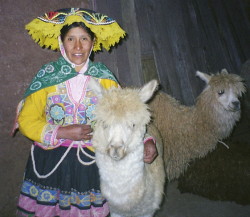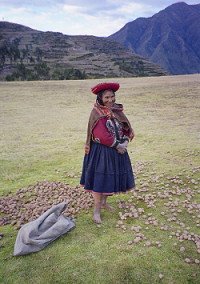
Photo. A native women in colourful customes! © Travel Explorations.
The most fascinating about the city is the people there and their customs. It was a very strange, but interesting mixture of Andean traditions, the old Europe and the new continent shaping. Another amazing thing was the great variety of potatoes, which is deeply rooted in the people`s culture and traditions.
Cuzco is located in the Peruvian Andes. In the city there is great diversity of customs and traditions, handicrafts and folklore dances. It offers magnificent expressions of Pre-Columbian and Colonial art, pottery, textiles, silverware, candleware and imageware.
Cuzco is also a pulsating city with several festivals during the year. These festivals are based on Andean customs and dance, influenced by Inca traditions. It was wonderful to see local Indians dressed up in their beautiful and colourful costumes. Their smiles melted my heart. Such friendliness made my travelling really rewarding in Peru.
Dramatic history
The history is full of dramatic incidents. It can never be complete before all the mysteries connected to the ancient structures are solved. Why and how did the people in the past build these amazing wonders?
Cuzco was as mentioned the Inca capital in the past. It was the heart, the very centre of the Andean world, the capital of Twantinsuyu, the so-called "Empire" that extended over nine-tenths of western South America. It was built under the Inca ruler Pachacutec, into a complex urban centre with distinct religious and administrative functions.
In 1533, the Spanish invaded the city and in 1534 the Spanish "founding" of Cuzco took place under Francisco Pizarro, who named it "the Most Noble and Great City of Cuzco". In 1983 the world organisation UNESCO notified Cuzco as a World Heritage site.
The Quichua Indians are formerly the most dominant people of the Empire of Peru, and still the largest group of Indians. The name is also written Qquichua, Quechua, Kechua.
The Inca seem to have had their original territory somewhere between Paucartambo and Cuzco. The Quichua proper, living south from Cuzco, were among their earliest conquests.
The land of the potatoes
Most people in Cuzco speak Quechua, and the local names of most fruit and vegetables are different from other Spanish speaking countries.
Avocados are "palta" and some potatoes are called "ayucos." There is a variety of tropical fruits including oranges, pineapples, papayas and figs, and a fair amount of fresh vegetables like broccoli, cabbages, root vegetables, etc. but the most amazing thing was the variety of potatoes.
Therefore it is no coincidence that Peru has made the potato available to the world. In some markets there were 20 to 30 varieties of potatoes, and my guide told me that there once were over 200 varieties grown in Peru, maybe more.
There are approximately 3000 varieties registered in the International Center of Potatoes (ICP). Peru has the greatest variety of potatoes in the world.
|
Photo. The "Potato" woman" outside Cuzco. A wide range of varities and tastes for everyone. © Travel Explorations.
The potatoes were offered in many colours, sizes, shapes and tastes. Some are usable for drying, a good way of preserving them, while others have high sugar content.
Not surprisingly I eat a lot of potatoes during my stay in Peru. It`s good for my health, I think.
|
 |
The potatoes were prepared in many ways, but it would take a long time to tast all the creative varities.
The background for Cuzco`s shape and structure today
In the early 1400s the ninth Inca, Pachucutec, began the expanding the Inca tribe. Pachucutec was a great urban developer, as well as politician. He designed Cuzco in the shape of a Puma, whose head and teeth are formed by the fortress of Saqsayhuaman.
He was also responsible for the construction of the building Qorikancha (The Garden of Gold), the most important structure in the entire empire. Qorikancha was covered with plates of gold, and its interior contained a series of temples dedicated to the sun, moon, rainbow, stars, and thunder and lightning.
Golden, bejewelled objects were found throughout, and the Temple of the Moon was covered in sheets of silver. The courtyard, or "golden garden" contained life-size gold replicas of the animals and plants of the kingdom.
Stein Morten Lund, 16 February 2006
Additional information
Read more about Peru on our global travelguide www.TravelExplorations.com













